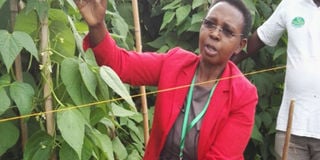Researchers release hybrid bean varieties

Dr Imelda Kashaija explains how the Narobean 5C grows. PHOTO by Lominda Afedraru
What you need to know:
- Dr Stanley Nkalubo, of NaCRRI has advised farmers to plant the latest hybrid bean varieties code named Narobean 1, 2, 3, 4C and 5C, writes Lominda Afedraru
Anemia which is an indicator of iron deficiency afflicts almost one out of two non-pregnant women and 50 per cent of children under five in Uganda.
Consumption of high iron beans has been proven to increase iron percentage in blood and as such scientists at the National Crop Resources Research Institute (NaCRRI) in Namulonge have successfully bred bean varieties rich in iron and zinc.
The new beans classified as Narobean 1, 2, 3 4C and 5C will complement other strategies that are currently in place to address iron deficiency.
Lack of iron can impair mental and physical development. Severe anemia often caused by iron deficiency, increases risks to women during childbirth and can cause death.
Recent reports from Naro indicate that despite efforts to curb iron deficiency through supplements and fortified foods, iron deficiency remains the most widespread nutrition deficiency, affecting an estimated 1.6 billion people worldwide.
Dr. Stanley Nkalubo, head of bean research at the NaCRRI confirmed the new high yielding highbrid.
The scientists began breeding the bean varieties using conventional methods in 2010.
Agronomy
The Narobean1 variety matures in 60 – 68 days with yield capacity of 1,500 – 2,000kilogrammes per acre.
It is best suited for low altitude areas and can escape drought periods.
Narobean2 matures in 58 – 68 days and yield capacity is 1,600 to 2,200 kilogrammes per acre.
Narobean3 matures in same period as Narobean2 and yields between 1,500 to 2,000 kilogrammes per acre.
The seed preparation should be fine seedbed to ensure uniform growth and planting is done when the soil has enough moisture.
Farmers must plant fine sorted seed and spacing is 50cm by 10cm. To grow one acre one needs 80 – 90 kilogrammes of seed and weeding is done three times after planting. It is advisable to apply NPK and Urea fertilisers with amounts of 50kilogrammes per acre and DAP OF 100kilogrammes per acre.
The climbing bean varieties mature in 82 – 96 days, yielding 2,500 3,700 kilogrammes per acre.
It is important for farmers to ensure there are sticks planted 50cm by 20cm to support the climbing beans. Farmers are advised to use staking materials like elephant grass, banana fibre, sisal strings and papyrus placed in different formations.
Pests and diseases
Beans are commonly attached by bean stem maggot, flower thrips and aphids and insecticide spray is highly recommended.
There are diseases such as anthracnose, angular leaf spot, bacterial blight and mosaic virus and farmers are advised to plant clean seeds to avoid disease spread.
Statistics
Paul Mwambu working with Uganda Multi -sectoral Food Security and Nutrition project at MAAIF explaining the statistics noted that there are 29 per cent of Ugandan children who are stunted and as such the bio fortified bean varieties are the best solution.
He said this project is targeting 15 districts with challenges of malnourished children and pregnant mothers namely Kamuli, Kibale, Kabale, Masindi, Kanungu, Isingiro, Gulu, Oyam, Lira, Arua, Nebbi, Mukono, Masaka, Rakai and Kamwenge. The entry point is mainly schools and farmer groups.
So far 1,000 demonstration gardens have been established in different schools.


